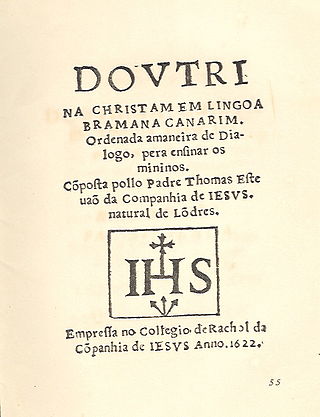Konkani_literature
Konkani literature is literature in the Konkani language, mostly produced in three scripts: Roman, Devanagari and Kannada. Konkani literature is eligible for the Sahitya Akademi Award.

While the earliest inscriptions in Konkani date from around the end of the first millennium, the first writer in the history of Konkani language known to us today is Shamaraja; who was also known as Krishnadas Shama as he was an ardent devotee of Lord Krishna. He was born in the 15th century AD in the village of Quelossim in Goa. As per the date mentioned in his Shrikrishnacharitrakatha, he began writing his book on 13th of the Vaishakha month of the Hindu lunar calendar, which is 25 April 1526, according to the Gregorian calendar. He authored Ramayana, Mahabharata, and Krishnacharitrakatha in prose style. The manuscripts have not been found, although transliterations in Roman script are found in Braga in Portugal. The script used by him for his work still remains a mystery.[1]
According to the orders of the Goa Inquisition, which commenced in 1560, it was an offence to remain in possession of books in local languages. All books, whatever their subject matter, written in Konkani, Marathi, or Sanskrit, were seized by the inquisition and burnt on the suspicion that they might deal with idolatry. It is probable that valuable non-religious literature dealing with art, literature, and sciences were destroyed indiscriminately as a consequence. For instance, even before the inquisition orders, in a letter dated 24 November 1548, Fr. Joao de Albuquerque proudly reports his achievement in this direction.[2]
Vishnudas Nama who also used pen names like Vaishampayana and Parameshvaraco Sharanagat Nama, authored Bhishmaparva and Adiparva, transliterations of which are found in the public library of Braga in northern Portugal.[3] Another copy of Ramayana does not bear any author's name, although the name of a certain "Sadashiva" has been mentioned.[3]
The Jesuits established the first printing press in Asia in Goa in 1556.[4] The first known printed book in Konkani was written by an English Jesuit priest, Fr. Thomas Stephens in 1622, and entitled Doutrina Christam em Lingoa Bramana Canarim (Old Portuguese for: Christian Doctrine in the Canarese Brahman Language). The first book exclusively on Konkani grammar, Arte da Lingoa Canarim, was printed in 1640 by Father Stephens in Portuguese.[5] Similarly, a book named A Konkani Grammar, was printed in the year 1882 in Mangalore by Angelo Francesco Saverio Maffei, and describes Canara Konkani grammar.[6]
The late nineteenth century saw the emergence of Konkani as a modern literary language, particularly through the pioneering work of the Goan writers Shenoi Goembab (1877–1946) and later Ravindra Kelekar (1925–2010), who wrote some of the twentieth century's foremost Konkani literature.[7] Alongside these writers, a wave of pulp fiction began around the 1930s, with writers including Caridade Damaciano Fernandes, Reginald Fernandes, and Eliot Ely.[8] The first Konkani novel to be translated into English was the 1977 Acchev by Pundalik Naik (1952–).
- Bhembre, Uday (September 2009). Konkani bhashetalo paylo sahityakar: Krishnadas Shama. Sunaparant Goa. pp. 55–57.
- Saradesāya, Manohararāya (2000). A history of Konkani literature: from 1500 to 1992. Sahitya Akademi. p. 317. ISBN 978-81-7201-664-7.
- Gomes, Olivinho (1997). Medieval Indian literature: an anthology, Volume 3 Medieval Indian Literature: An Anthology, K. Ayyappapanicker. Sahitya Akademi. pp. 256–290. ISBN 978-81-260-0365-5.
- A.K. Priolkar, The Printing Press in India: Its Beginnings and Early Development being a quatercentenary commemoration study of the advent of printing in India in 1556, (Bombay: Marathi Samshodhana Mandala, 1958).
- Saradesāya, Manohararāya (2000). A history of Konkani literature: from 1500 to 1992. New Delhi: Sahitya Akademi. pp. 1–3. ISBN 978-81-7201-664-7.
- Maffei, Angelus Francis Xavier (2003). A Konkani grammar (in English and Konkani). ISBN 9788120600874. Retrieved 22 April 2010.
- Kiran Budkuley, 'Modern Konkani Classics', Muse India, 64 (November–December 2015), http://www.museindia.com/focuscontent.asp?issid=50&id=4272 Archived 4 March 2016 at the Wayback Machine.
- ManoharRai SarDessai, A History of Konkani Literature: From 1500 to 1992 (New Delhi: Sahitya Akademi, 2000), pp. 227-28.